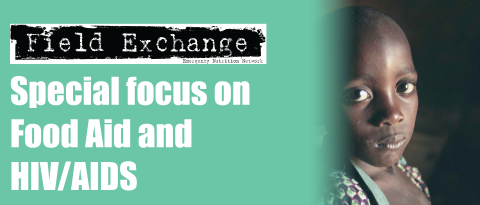Three Ingredients of Success: Targeting Food Assistance in Western Kenya
By Karine Garnier, Ruth Situmu and Ben Watkins, WFP
Kenya Karine Garnier (MPA) is a consultant now working with FAO
Ruth Situma (MSc Public Health and Nutrition) is a nutritionist with WFP Kenya
Ben Watkins (MSc Ag. Econ.) is programme advisor for WFP Kenya

Many hands sharing the family pot
WFP supports a project, Nutrition and Care of the People Affected by HIV/AIDS, implemented by the Government of Kenya, NGOs and community based organisations (CBOs), in Busia district in Western Kenya. Busia district was selected due to a high HIV sero-prevalence (over 15 percent) and relatively high rates of rural poverty. The project commenced in 2003 and provides a basic food ration to 24,700 food insecure and HIV/AIDSaffected people. The ration meets 57 percent of the total dietary energy requirements of the targeted households. WFP's food assistance complements other HIV/AIDS mitigating activities in Busia district, including provision of anti-retroviral therapy.
Delicacy of targeting
A baseline survey, undertaken prior to implementation, found that the households that are most directly affected by HIV/AIDS, such as those with bedridden adults, with grandparent heads, or hosting orphans, are not always the poorest and most food insecure. In particular, a significant number of orphans live in better off households. This poses a targeting problem since WFP is committed to feeding only the hungry poor, and lacks the resources to cover all HIV/AIDS affected households in Busia. Thus, WFP has applied a dual targeting criterion, to identify households that are both affected by HIV/AIDS and are food insecure. This is challenging because targeting HIV/AIDS-affected householdS is very delicate, with a risk of creating stigma. In addition, it is costly and difficult to evaluate food security status at a household level.
Impact
An impact survey was conducted in 2004 in five operational areas. On both criteria, Butula Division had the highest target efficiency, i.e. the majority of the people receiving food assistance were clearly both HIV/AIDS affected and food insecure in the absence of food assistance. Only two percent of eligible people were excluded from the programme. The partner in Butula is the Rural Education and Economic Enhancement Programme (REEP), a CBO under the dynamic and inspired leadership of Mary Makokha. So what are the main ingredients of REEP's success?
1. Community-driven and community based:
The food is provided through elected Community Management Committees (CMC), which are independent of the local political and patronage structures, and generally comprise affected or infected people. The staunch independence of REEP ensures that, for the most part, food allocation is decided based on needs, and not on influence. REEP officers know the community intimately, well enough to be able to verify the CMC participant lists.
2. Women in the driving seat:
As with all WFP programmes, women's participation was encouraged and facilitated in all the stages of the Busia project. Over two-thirds of the CMC members are women. Women tend to have better information on the relevant household characteristics, and most community members consider the CMC to be much fairer than the male-dominated local leadership structures.
3. Tackling stigma:
REEP has done an extraordinary job, building people's selfesteem and enabling them to speak freely about their HIV status. When people are found to be HIV positive, they are referred to a support group headed by a community health worker, and their food security situation is assessed in order to determine their eligibility for food assistance. This improves the quality of the targeting, by encouraging more destitute and infected people to come forward.

With the right quantities of food getting to the right people, the impact of the food assistance has been very positive. The proportion of poor households consuming adequate kilocalories has doubled. Participants report a tremendous improvement in their health, self-confidence, and entrepreneurship.
According to Mary Makokha there have been "resurrections" among the bed-ridden patients receiving CSB rations from WFP. On visiting Butula with ENN, WFP met a woman who was bedridden before the project but is now farming her own land, and has even increased her plot size. Although the programme targets the poorest households in Butula, there were no children suffering from wasting among those surveyed.
While the REEP experience has encouraged WFP to expand the food assistance programme, the agency is aware of the need to complement short-term food assistance with longer-term food security initiatives. In Butula and other project sites, WFP partners are setting up income-generating projects, like poultry and pork raising. These activities do not require heavy labour, so they are appropriate for households affected by HIV/AIDS.
Of course, effective targeting is not enough. In Butula, food support is an essential tool for mitigating the food security impact of HIV/AIDS, but is only one input in the support package. REEP's comprehensive home-based care programme offers targeted households a support package, which is complemented with WFPs food assistance.
See related field article, REEP experiences in Western Kenya, p26
For further information, contact WFP Kenya, UN Gigiri Compound, Nairobi, Kenya Tel: +254 20 622043/622233, Fax: +254 2 622263, email: WFP.Nairobi@wfp.org The authors can be contacted by email: KGarnier@faonairobi.or.ke, Ruth.Situma@wfp.org, Ben.Watkins@wfp.org
Imported from FEX website


